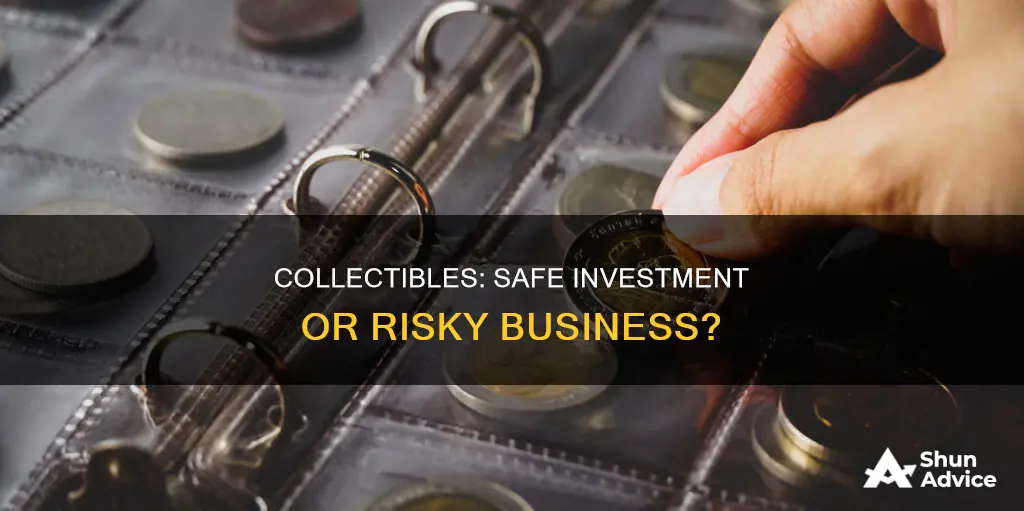
Collectibles are considered alternative investments to stocks, bonds, mutual funds, exchange-traded funds (ETFs) and cash. They can be a source of diversification for those heavily invested in securities, but they are generally less reliable as investments than stocks or bonds. Their value can be subjective and fluctuate based on trends in collector interest, and they don't typically generate passive income. However, collectibles can provide psychological benefits for owners.
| Characteristics | Values |
|---|---|
| Considered alternative investments | Less reliable than stocks or bonds |
| Subjective value | Fluctuates based on trends in collector interest |
| No passive income | Maintenance costs |
| Risk of counterfeits | Lower returns than other investments |
| Diversification | Potential for liquidity issues |
| Price volatility | Need to buy low and sell high |
| Business activity | Need to demonstrate intent to make a profit |

Price volatility
For example, the value of a vintage automobile may increase over time as it becomes more rare and sought-after. However, if a new model of the car is released, or if there is a shift in collector interest towards more modern vehicles, the value of the vintage automobile could decrease.
Similarly, the value of a piece of art may increase if the artist gains recognition or if the work is exhibited in a prestigious gallery. However, if the artist falls out of favour or if there is a shift in artistic trends, the value of the artwork could decrease.
It is important for potential investors in collectibles to be aware of these risks and to research the market thoroughly before making any purchases. It is also important to consider the maintenance costs, insurance, and security of the items, as these can impact the overall return on investment.
NRIs: Understanding the Portfolio Investment Scheme
You may want to see also

Liquidity
Collectibles are considered an alternative investment to stocks and bonds, and they are generally less reliable. Their value can be subjective and fluctuate based on trends in collector interest. This means that they may not be a liquid investment, as they cannot be acquired and sold with relative ease. Depending on the marketplace, you might get "stuck" holding assets without a reasonable offer on the horizon.
The liquidity of collectibles as an investment is also impacted by the potential for price volatility. The value of certain collectibles can fluctuate widely, and it is important to buy low and sell high. This can make it difficult to sell collectibles at a profit, especially if the market for a particular collectible is limited or if there is a lack of demand.
Another factor that affects the liquidity of collectibles is the potential for maintenance costs. Collectibles often incur maintenance costs, such as insurance, storage, and authentication fees. These costs can reduce the overall return on investment and make it more difficult to sell the collectible at a profit.
In addition, the liquidity of collectibles can be impacted by the risk of counterfeits. The presence of counterfeits in the market can reduce the demand for authentic collectibles and make it more difficult to sell them at a premium. This can further reduce the liquidity of collectibles as an investment.
Overall, while collectibles can provide a return on investment and serve as a source of diversification, they may not be a liquid investment. Potential investors should carefully consider the potential pitfalls, including liquidity issues, before investing in collectibles. It is important to research the market and have a personal interest that can provide psychological benefits in case the investment does not perform as expected.
A Guide to ELSS Investments in India
You may want to see also

Maintenance costs
Insurance is necessary to protect your investment in the event of damage or loss. The cost of insurance will depend on the value of the collectible and the level of coverage you choose. It is important to shop around and compare prices from different insurance providers to find the best rate.
Storage costs can also add up, especially if you have a large collection or items that require specific conditions, such as temperature or humidity control. For example, wine collections may require a climate-controlled storage unit, which can be expensive.
Security is another important consideration, especially for high-value collectibles. You may need to invest in a safe or security system to protect your investment from theft or damage. This can include alarms, cameras, or even hiring security personnel.
In addition to these ongoing costs, there may also be one-off expenses, such as restoration or repair of damaged items. It is important to factor in these potential costs when considering investing in collectibles. While they can provide diversification and psychological benefits, they are generally less reliable as investments than stocks or bonds and may incur significant maintenance costs.
Amazon's Indian Investment: Strategic Business Move
You may want to see also

Diversification
Collectibles are considered alternative investments to stocks and bonds, and are generally less reliable. Their value can be subjective and fluctuate based on trends in collector interest. They also don't usually generate passive income and can incur maintenance costs.
However, collectibles can be a good way to diversify your portfolio. If you are heavily invested in securities, collectibles can be added to your holdings to reduce your overall investment risk.
There are several potential pitfalls to investing in collectibles. Liquidity can be an issue, as it may not be easy to sell your assets. Price volatility is also a factor, with the value of certain collectibles fluctuating widely. It's important to buy low and sell high.
If you are considering investing in collectibles, it's important to do your research and be aware of the potential risks, including the risk of counterfeits and lower returns than other investments. You should also consider the need for proper insurance and securing the items.
Understanding Investment Risk: Making Informed Decisions
You may want to see also

Psychological benefits
While collectibles are considered alternative investments, they are generally less reliable than stocks or bonds. Their value can be subjective and fluctuate based on trends in collector interest. They also don't typically generate passive income and frequently incur maintenance costs. However, investing in collectibles can provide psychological benefits for owners.
Firstly, collectibles can be a source of pride and enjoyment for their owners. Owning a rare or valuable collectible can give a sense of accomplishment and satisfaction. It can also be a way to showcase one's taste, knowledge, or expertise in a particular area. Secondly, collectibles can provide a sense of security and stability. They are tangible assets that can be physically possessed and protected, which may give a sense of control and peace of mind, especially during times of economic uncertainty. Thirdly, collectibles can offer a sense of connection and community. Collecting can be a social activity, with collectors often joining clubs, attending auctions, or participating in online forums to connect with like-minded individuals. This sense of belonging and shared interest can enhance the psychological benefits of owning collectibles. Finally, collectibles can provide a sense of legacy and continuity. They can be passed down through generations, becoming family heirlooms that carry emotional and sentimental value. The idea of preserving and continuing a collection can give a sense of purpose and contribute to a sense of long-term satisfaction.
Understanding Your Investment Risk Tolerance: An Everfi Guide
You may want to see also
Frequently asked questions
Collectibles are considered alternative investments and are generally less reliable than stocks or bonds. Their value can be subjective and fluctuate based on trends in collector interest.
There are several potential disadvantages to investing in collectibles, including liquidity issues, price volatility, maintenance costs, the risk of counterfeits, and the potential for lower returns than other investments.
Collectibles can include fine wine, fine art, vintage automobiles, guitars, baseball cards, stamps, gold coins, and even commemorative Elvis Presley porcelain.
Factors that can demonstrate an honest intent to make a profit from investing in collectibles include conducting the activity in a businesslike manner, keeping good records, searching for profit-making strategies, having expertise in the activity or hiring expert advisors, and spending enough time on the activity to justify it as a business rather than a hobby.







